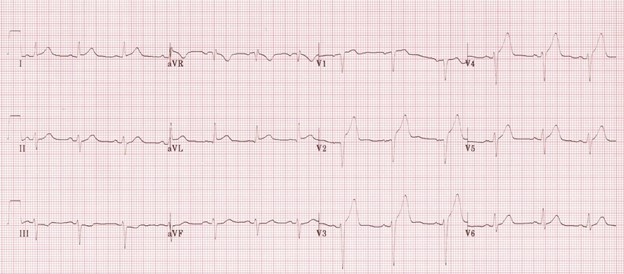Acute Coronary Syndrome Flashcard 6
Rationale
D. Rationale: Goals of ACS therapy include identification and treatment of ACS and its symptoms.
Question
The primary goals of ACS therapy is/are:
a. Identification of patients with STEMI
b. Identification of patients with atherosclerotic disease
c. Relief of ischemic chest discomfort
d. A and C
Answer
d. A and C
Rationale
C. Rationale: NSAIDs are associated with an increased risk of mortality, reinfarction, hypertension, heart failure, and myocardial rupture and should be discontinued during hospitalization.
Question
Use of nonsteroidal anti-inflammatory drugs (NSAIDs):
a. Is recommended if aspirin is not available in the setting of ACS
b. Has a beneficial effect on platelet aggregation
c. Is associated with an increased risk of mortality and reinfarction
d. Should not be discontinued if the patient is taking NSAIDs prescribed for another condition
Answer
c. Is associated with an increased risk of mortality and reinfarction
Rationale
D. Rationale: The FMC-to-balloon time for PCI is 90 minutes. For fibrinolytic therapy, the door-to-needle time is 30 minutes.
Question
What is the allotted first medical contact-to-balloon time to perform percutaneous coronary intervention in a patient with ST elevation myocardial infarction?

a. 15 minutes
b. 30 minutes
c. 60 minutes
d. 90 minutes
Answer
d. 90 minutes
Rationale
C. Rationale: Acute coronary syndrome is the leading cause of cardiac arrest and cardiac death if left untreated. Once diagnosed, the definitive treatment is providing early reperfusion therapies to increase survival rates.
Question
What is the goal of the emergency treatment of patients with acute coronary syndromes?
a. Pain relief
b. Oxygenation and ventilation
c. Immediate reperfusion
d. Early CPR and defibrillation
Answer
c. Immediate reperfusion
Rationale
C. Rationale: This is a case of a high-risk non-ST elevation ACS. ST segment depression is indicative of myocardial ischemia, and the presence of increased cardiac troponins makes this a high-risk case. Early reperfusion strategies are recommended, such as PCI with adjunctive therapies such as nitroglycerine, morphine, and oxygen. If PCI is not feasible after the initial coronary angiogram, other invasive strategies may be performed, such as coronary artery bypass graft.
Question
What is the next course of action for a 60-year-old man with ST depression on ECG and elevated cardiac troponins?
a. Admit to observe and perform other diagnostic tests
b. Send patient home
c. Perform percutaneous coronary intervention
d. Admit for coronary artery bypass graft
Answer
c. Perform percutaneous coronary intervention
Rationale
A. Rationale: Percutaneous coronary intervention is the treatment of choice for the management of ST elevation myocardial infarction.
Question
What is the treatment of choice for a patient with ST elevation myocardial infarction?
a. Percutaneous coronary intervention
b. Fibrinolytic therapy
c. Warfarin therapy
d. Adjunctive therapy
Answer
a. Percutaneous coronary intervention
Rationale
D. Rationale: STEMI, new-onset left bundle branch block, and non-ST elevation acute coronary syndrome can cause sudden cardiac death. These syndromes are due to coronary artery occlusion.
Question
Which of the following conditions can cause sudden cardiac death?
a. Nonspecific ST-T wave changes
b. New right bundle branch block
c. Deep Q-waves
d. Non-ST elevation myocardial infarction
Answer
d. Non-ST elevation myocardial infarction
Rationale
D. Rationale: Part of the ACLS platform is diagnosing and managing acute coronary syndrome, an umbrella term for coronary heart disease that causes acute myocardial ischemia (unstable angina), non-ST segment elevation myocardial infarction, and ST segment elevation myocardial infarction.
Question
Which of the following disease conditions is part of acute coronary syndrome?
a. Unstable angina
b. Non-ST segment elevation MI
c. ST segment elevation MI
d. All of the above
Answer
d. All of the above
Rationale
A. Rationale: Morphine, oxygen, nitroglycerin, and aspirin (MONA) are given as part of the immediate ED general treatment for patients with ACS. Epinephrine is used to treat a variety of dysrhythmias.
Question
Which of the following drugs is not included as part of the ED general treatment for chest pain?
A. Epinephrine
B. Aspirin
C. Morphine
D. Nitroglycerin
Answer
A. Epinephrine
Rationale
C. Rationale: Prevention of plaque formation is not a goal of treatment for ACS. Plaque will already have formed in patients with ACS. Goals for therapy include relief of ischemic chest pain, identifying and triaging patients with STEMI for early reperfusion therapy, and preventing acute, life-threatening complications such as arrhythmias.
Question
Which of the following is NOT a primary goal of treatment for acute coronary syndromes?
A. Early reperfusion
B. Relief of ischemic chest pain
C. Prevention of plaque formation
D. Treatment of acute life-threatening complications such as arrhythmias
Answer
C. Prevention of plaque formation